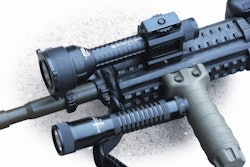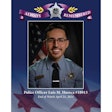You have many opportunities for training outside of your agency. There are a bewildering number of classes offered by martial artists, veterans of elite military units, retired law enforcement officers, and the manufacturers of police equipment. But how do you tell which classes are suitable for you and whether what you learn in those classes will work on the street?
First of all, you have to consider your needs and your abilities. Make sure you have the physical endurance and flexibility to participate in the program. Regardless of how strong or how fit you think you are, there are programs that will tax you. You also need to consider any past injuries, weak joints, or other health concerns that might come into play during the class. If you’re not sure, ask the instructor.
While you’re at it, ask the instructor if anyone has ever been hurt in the class. What is the instructor’s safety record?
The next concern after your health is cost. Some of these programs can cost you some serious money. But don’t let finances prevent you from getting the training you need. There are grant programs that can help you pay for training; you can sign up for conferences like TREXPO and get some great training at a reasonable price; you may even be able to get your agency to pay for it. Don’t laugh. Some will pay the freight, especially if you can bring the skills that you learn back to your agency and train your fellow officers.
Look at training as an insurance policy rather than a budgetary restriction. Training saves lives; budgets only save money. Ask yourself, how much is your deductible?
Finally, you have to determine if the class is really going to benefit you. Does the instructor know his or her stuff? Will the techniques work on the street? Can you execute the moves that you learn after the class? How much fine and gross motor skills are required? In other words, is the program any good?
One way to learn about a class is to talk to other cops who have experience with it. But make sure that the people you talk to have actually taken the class. Some people just love to give opinions on things they don’t know anything about.
KNOW YOUR INSTRUCTOR
There are essentially three types of law enforcement trainers: the professional trainer, the career trainer, and the product trainer.
The professional trainer develops and creates new training programs for other trainers based on what is needed in the field. He or she determines this need through research, including discussions with other officers and experts. Often this individual is a retired officer.
The career trainer is the training officer in charge of conducting the training for an agency or a particular unit within an agency. This individual is a veteran officer who is still on the job and who has excelled at training, learning new techniques, and evaluating techniques to see if they are suitable for his or her agency.
Product trainers are the people that the manufacturers dispatch to teach you how to get the most out of their products. Most are retired law enforcement officers or military veterans.
One good way to check out the credentials of an instructor is to look at his or her publications. Not all good police trainers write, but many do. Do a search on the Internet and see what pops up under the instructor’s name. You are likely to find books and magazine articles. Read them and use them to determine if the instructor can teach you what you want and need to know.
FIGHTERS AND TEACHERS
Throughout my career, I have put trainers and their programs in two different categories: those who are skilled fighters and those who are skilled at teaching their students how to fight.
The two categories are not exclusive. Some very good teachers are also excellent tacticians and combatives. But you don’t want a guy who has no street experience with his techniques. You also don’t want a guy who is the world’s greatest fighter, but he can’t teach. This is how students get hurt.
Ask yourself this question when considering the quality of an instructor: If my life was on the line, and I was fighting for my life would I want this trainer to come and help me? More importantly, would I want the officers I trained in this trainer’s techniques to come help me?
What I’m getting at here is the practical application of the instructor’s techniques and the portability of the training. This is important because not all cops are martial artists, and we shouldn’t expect ourselves to have the time to master complex martial arts techniques.
Look at it this way: About 85 percent of martial artists keep their weight proportionate to their height; they work out daily; they eat the right foods; and they actively practice their techniques for about 15 hours per month. If you average this over a 20-year time period, you will see that the average martial artist spends thousands of hours learning and honing his or her skills.
In contrast, about 85 percent of officers on most departments do not keep a daily physical fitness regimen; they suffer health problems such as bad knees, bad backs, and high blood pressure; and they smoke, eat too much fat, and drink too much caffeine. So they’re not exactly in tip-top shape. And even if they are fit, their training time is extremely limited. They maybe get 24 hours per year of in-service training, and another six hours per year of personal training. Well…You get my point.
Any fighting or physical control skill that the average cop learns must be easily learned, easily duplicated under stress, and easily maintained. If the training program you’re taking doesn’t meet these requirements, then it’s probably not doing you a lot of good.
THE 3Cs
The three most important things to look for in a training program are what some trainers call the “3Cs.” You want the training to be consistent, coordinated, and complete.
Consistent refers to consistency with current case law and modern training principles. If what you are learning is unacceptable in court and it doesn’t match the needs of your agency, then it’s useless in all but the most extreme circumstances. For example, if your agency prohibits certain control measures, you should think twice before spending a lot of time and money learning how to do them. An exception to this rule is if you are researching them so that you can persuade your administrators or civilian oversight to change their policies.
Just remember the following advice from Roy Bedard, a police use-of-force expert and the president of Rapid Rotation Baton. “Any training program that proposes to radically change the ingrained methods of operation for cops can cause dysfunction and create mental blocks under stress.” This is why it is critically important that the training you receive outside of your agency is consistent with the training you receive from your agency. This is not always possible, but you need to be aware of when the two don’t agree.
Coordinate your training to meet your department’s specific needs. Nobody knows the plays like the players. What has happened in your department will most likely happen again. Learn from your department’s history and train for that.
Remember, one of the best things about taking classes outside of your agency is that you can bring the knowledge back to your colleagues. However, the training must also be coordinated with your supervisors and departmental policy. There is little worse than having your chief yell, "You trained them to do what?" The training should also be coordinated with all of your instructors. You should not have a firearms instructor's training conflict with the training of your DT instructor and vice versa.
Finally, make sure that the training classes you take are complete and they teach you how to integrate the techniques into your use-of-force continuum and how to verbalize what you did and why.
You are not training to fight in a karate dojo. You are training to become a more effective police officer and improve your chances of returning home healthy at the end of your shift. Consequently, any police training you take should include all aspects of the confrontation. It should teach you correct verbalization before, during, and after. It’s also critically important that it focus on not just knocking down the subject but also taking him or her into control by handcuffing.
Let’s apply the concept of completion to a weapon-stripping class. A complete class should include the following:
• Stripping the weapon (knife, gun, club) from the attacker
• Maintaining safe control of the attacker once you have stripped the weapon
• Disengaging, moving to cover, and drawing your duty weapon if necessary
• Ordering the offender into a position of control
• Calling for backup
• Employing cover and contact principles to safely take the subject into custody
Yes, I understand that your years of academy and in-service training, not to mention your years of experience on the street, have taught you how to perform basic police functions like handcuffing a suspect and calling for backup. So do you really need to include these operations in an advanced DT class?
Absolutely. Here’s why: It has been proven time and again that cops will revert to their level of training under stress. So you don’t want to learn how to strip a weapon or knock a suspect down, or whatever unless it is incorporated into the big picture of taking the offender into control and ensuring that no one else is going to attack you. If you learn to just strip the weapon and stand there just holding it in class, odds are that’s what you’ll do on the street.
PRODUCT TRAINING
So far we have focused primarily on defensive tactics training. As we have discussed, this training can be quite costly in terms of travel and tuition. But there is a way to gain valuable law enforcement training on a budget, sign up for product training.
If your agency is making a major purchase of a product, many manufacturers will send their trainers to you and supply you with training as part of the deal or at a nominal additional cost.
I am the director of training for RedMan Training Gear. If you come to one of my classes on how to get the most out of RedMan gear, you would learn the following:
• An overview about the gear, including how to put it on, what it’s made of, what it can and can’t protect you from, etc.
• How to move in the RedMan suit, and how to safely receive blows while wearing the equipment.
• How to clean, sanitize/disinfect, pack, and perform simple repairs on the equipment.
There are a lot of benefits to product training. And one really good thing about it is that you know the trainer has already been checked and approved by the company he or she represents.
Veteran police officer Mike Lowe is the president of holster manufacturer Tactical Design Labs, and he is very thorough when it comes to checking out the company’s trainers. Not only is Lowe looking for practical experience and professional knowledge when he screens trainers, he’s also looking for the proper attitude.
“There are several things that I look for in a trainer,” Lowe says. “I’m looking for a valid experience base, but I also want to see sincerity and humility on the trainer’s part.”
He adds, “The most critical element in evaluating the validity of realistic training is ensuring that the training is framed within a realistic mindset.” Lowe says that all techniques and concepts of police training can be defeated with prior knowledge. And he advises, “We must continually keep this in mind and prevent the trainers’ egos or competitiveness from compromising the training and the trainees’ confidence.”
BEFORE YOU SIGN UP
OK. Let’s say you’ve checked out the instructor. You know that the techniques taught in the class are consistent with your agency’s policies, and they can be used in the real world. You’ve decided to take the training. Great. But first you need the answers to the following questions:
• Are you covered or protected from liability during the class?
• After you complete the class, what support will the trainer or manufacture offer you in defending the training material in court?
• How long is this training valid? If this training is about to be superseded by new policy or technology, don’t waste your time and money.
• Does the trainer offer a money-back guarantee? The old saying “You get what you pay for,” is very misleading in this field. If you attend the program and find out on the first day that this program is not for you, will you get a refund of your money? If you complete the training program and feel that it did not meet your expectations, can you receive a refund? If you completed the training program and have been unable to satisfactorily complete the testing process, can you receive a refund or any compensation?
• Will the trainer give you references? Don’t ask just to speak with the successful students. Ask the trainer to share the references of students who have failed. Get the list and contact who you want.
TRAIN HARD, TRAIN OFTEN
When selecting a training program, remember it is an investment. An investment of your time and money that should make you a better officer and enhance your safety on the job.
Make the most of your investment by practicing what you learn. All techniques and tactics are perishable and without continuing education and practice, you may not have the right skill level needed to safe your life when the chips fall.
In closing, remember this: Never let your own physical inabilities stop the progression of your department. DT stands for “defensive tactics,” not “don’t touch.”
Program Evaluation Checklist
Before you sign up for a special training class, make sure you have the answers to these questions:
•Who developed the program? What are his or her credentials?
•Who is the instructor? What are his or her credentials?
•Has anyone been hurt during this training? What is the instructor’s safety record?
•Does the class cover tactical application in the field and integrate the technique, tactic, or product into standard police operations such as controlling and arresting offenders?
•What agencies have taken the program?
•What are the certification requirements?
•How long is the certification valid?
•What are the recertification requirements?
•What are the testing procedures for passing or failing this class?
•Is there a refund if you cannot successfully pass the class?
•Will the trainer back you up if you end up having to defend the training or the use of the technique, tactic, or product in court?















